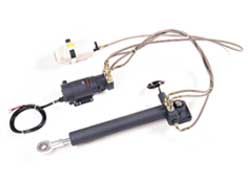
The general setup is a course computer connected to the Furuno MFD/8 set to steer to our next waypoint. There have been times when we had problems with the interface and would set the autopilot to steer to a compass heading, but it’s amazing how fast the cross track error piles up. Nonetheless, there are times when our desired course is DDW and due to the wind or sea state we choose to gybe down the course so we’ll set the autopilot to steer to a compass heading and then gybe when our cross track error reaches a certain amount (e.g., 2 miles).

Because we are so dependent on the autopilot, we have two. The second course computer is tucked away in a drawer where we hope it will survive a lighting strike, ready for installation if the primary computer fails. The autopilot has a dedicated heading sensor, as does the Furuno radar. But in a pinch, we can cross wire them to work with the other so their respective heading sensors are each other’s backup heading sensor. And a third heading sensor is in the drawer with the spare course computer. Then we have two linear drive units, the rams which actually turn the rudder, each with its own hydraulic pump. Only one ram is connected to the rudder quadrant at a time, but if necessary, we can disconnect one and connect the other while at sea (as we learned halfway between Bermuda and the BVIs). The pumps are wired through a switch which enables selection of either pump/ram combination without any rewiring. And this switch also reverses the polarity so that the ram will push/pulll in the correct direction without having to tell the course computer that we made the change.
Our first season we used a Furuno course computer with a pair of AccuSteer linear hydraulic drive units. In short, that was not a good solution. The Furuno autopilot would not hold course, particularly off the wind, and the AccuSteer drive units failed repeatedly. They were both replaced over the summer of 2009.

We are now using a Raymarine SPX30 course computer and Raymarine Type 3 hydraulic linear drive units. We have an ST6002+ wired controller and S100 wireless controller. We used a Raymarine autopilot on our previous boat and were very happy with its performance and reliability. Our first SPX30 course computer became erratic and failed within a few weeks, but the backup is working fine. Raymarine quickly exchanged the defective unit.
